It is only a matter of days before the first Osprey is likely to return to Rutland Water, but over the past few months we have received a number of sightings of Rutland birds which have been identified by their colour rings on their wintering grounds in West Africa and Iberia.
Rutland Ospreys in Winter

1K photographed in southern Senegal (Photo Credits: Joanna Dailey)
1K fledged from the Site N nest in Rutland in 2013 and has been breeding in the local area since 2018, raising five chicks. We know that 1K winters on the Inifouk Bolong in the Casamance region of southern Senegal because he was seen there for the first time by Joanna Dailey, Pip Rowe, Vic Paine and Jean-Marie Dupart on 5th November 2021. Adult Ospreys are faithful to the same wintering site each year, and Joanna, Pip, and Vic again logged him at Inifouk on 2nd January this year. Amazingly, on the same day, they located another Rutland Osprey, less than two miles to the west. What’s more, it turned out to be a half-brother of 1K. 357 was the middle chick of a brood of three males that fledged from the Site N nest in 2021, and Joanna photographed him flying over the mangroves, just 15 minutes after seeing 1K. This was the first confirmed sighting since 357 set off for migration in autumn 2021, and given the timing of the sighting, we can be almost certain that he will now regard this part of Casamance as his established wintering site. We now hope that the young male returns north to Rutland Water for the first time this summer. 1K and 357’s mother, 5N(04) is the oldest bird in the Rutland Water population and has now reared a total of 36 chicks since she first bred at Manton Bay in 2007. She moved to Site N in 2009 and has bred each year since with a total of four different males. A real matriarch of the Rutland population.

357 was located just two miles west oh his sister (Photo Credit: Joanna Dailey)
Prior to their trip to the Casamance region, Joanna, Pip and Vic were 130 miles further north in Senegal, and there they saw another Rutland Water male, 059, at Yenne Tode Lagoon on the coast to the south-east of the capital, Dakar. 059 fledged from the Site R nest in Rutland in 2019 and was seen at several locations in 2021, including Cors Dyfi in mid-Wales, Otmoor Reservoir in Derbyshire and finally in North Yorkshire, before eventually returning to Rutland, where he was photographed at Horn Mill Trout Farm on 27th August. Such explorations are typical of two-year-old Ospreys returning north for the first time. Last year 059 became a regular visitor to Horn Mill Trout from 7th May and was also photographed at Hollowell Reservoir in Northamptonshire on 27th July and at Cropston Reservoir in Leicestershire on 7th August. The fact we now know where he spends the winter again demonstrates the value of colour-ringing.
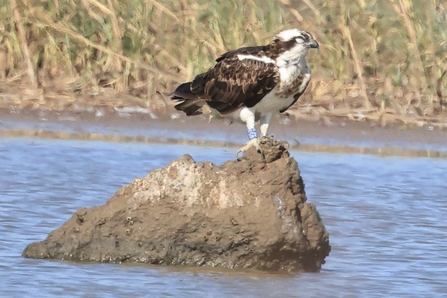
059 was seen at Yenne Tode Lagoon (Photo Credit: Vic Paine)
Another Osprey to be identified by its colour-ring on its West African wintering grounds was a bird that became known to many people last year. 1H3 was one of three chicks to fledge from the Manton Bay, watched by an online audience of thousands thanks to the webcam. She was the youngest of the brood of three, and fledged on 3rd July. She departed on her southward migration on 12th August, and we had no further sightings of her until 15th February when Clive Harding photographed her from a boat on the River Allahein, which forms the southern border between The Gambia and Senegal. This is prime over-wintering Osprey habitat, and an excellent place for the young female to have found on her first journey south.
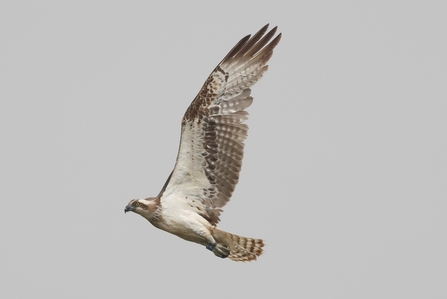
One of the 2022 Manton Bay chicks, 1H3, was seen between The Gambia and Senegal (Photo Credit: Clive Harding)
We know that The Gambia is the winter home of another Osprey from a nest in the Rutland Water area. 5F fledged from the Site K nest in 2012 and now breeds at Llyn Clywedog in mid-Wales. She has been seen in The Gambia on numerous occasions in recent winters, initially near the fishing village of Tanji and then more recently three miles further south at Tujereng. This year she was photographed by Chris Wood close to Tujereng on 12th December, and on a number of occasions thereafter.
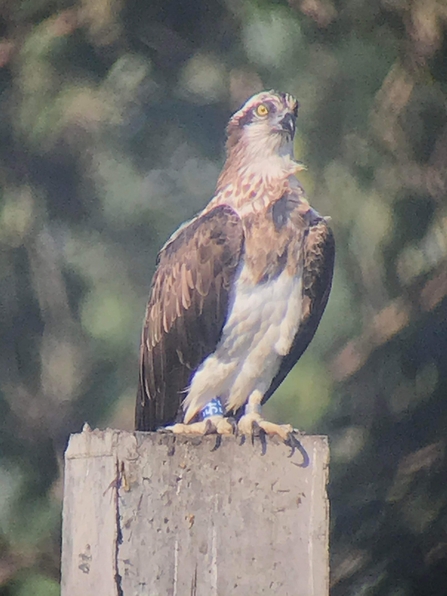
5F was captured close to Tujereng (Photo Credit: Chris Wood)
Not all Ospreys from the UK migrate to West Africa, with some only flying as far south as Iberia. On 22nd January Jorge Safara photographed 2AM on the River Tejo near Carregado, north-east of Lisbon in Portugal. 2AM is a male that fledged from the Manton Bay nest in 2017 and has spent time at Rutland Water and also Blithfield Reservoir in Staffordshire, since first returning in summer 2019. The River Tejo has become increasingly important for wintering Ospreys in recent years and Jorge and colleagues logged 30 different Ospreys on a 100km stretch of river on the day they saw 2AM.
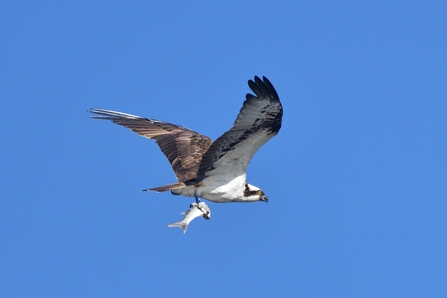
Not all Ospreys migrate to Africa! 2AM was seen near Carregado (Photo Credits: Jorge Safara)
On 7th February, another Manton Bay male, this time 055, who was one of four chicks to fledge in 2019, was seen on the River Limia near Vianno do Castela in northern Portugal by Pip Rowe and Vic Paine, who not content with their efforts in West Africa, were now in search of Ospreys in Iberia. Pip was able to read the ring number clearly though a telescope, and Vic also sent some photos. 055 has been seen back in Rutland the past two summers, but like the other younger males, is yet to breed. The fact that he winters in northern Portugal suggests he could be among the early arrivals this spring: his wintering site is more than 2000 miles north of the Casamance region of southern Senegal, giving him a distinct advantage in terms of distance to migrate.
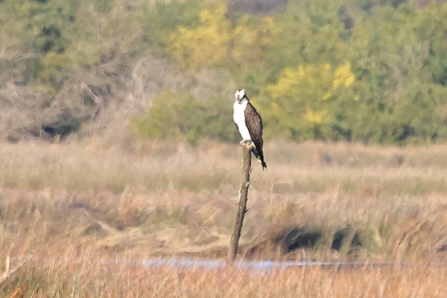
Another Manton Bay male, 055, was seen in northern Portugal (Photo Credits: Vic Paine)
An increasing number of northern European Ospreys also winter in Spain, and the Bay of Cadiz Natural Park in Andalucia is one of the most important sites. On 2nd February Jonathan Perera photographed 079 there. This young male fledged from a nest known as Site S in 2021 and his mother is 30(05), who we followed via a satellite tag for a number of years. 079 was the lone chick to fledge from Site S in 2021 and so must have been in good condition when he departed on migration that autumn. The fact that he was seen at Cadiz in February of his third calendar year, means this will now be his established wintering site. Interestingly we know that his father, T3(16) also winters in Spain, albeit much further north, because he was seen at Rianxo in Galicia on the north-west coast in January 2019. 30(05), meanwhile, winters near Lompoul sur Mer on the Senegalese coast mid-way between Dakar and St Louis. This winter she was seen on her favourite section of beach by Jean-Marie Dupart on 27th September having completed her 17th autumn migration.
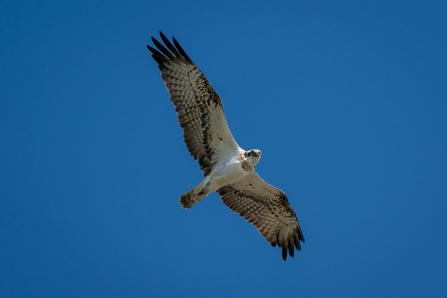
079 was photographed wintering in Andalucia (Photo Credit: Jonathan Perera)
The fact that so many different Rutland Ospreys have been seen this winter is unprecedented and testament to the value of colour ringing. We are very grateful to Jorge, Joanna, Vic, Pip, Jean-Marie, Chris, Clive and Jonathan for their valuable fieldwork, and for allowing us to share their excellent photos. Thanks and well done to them all.

